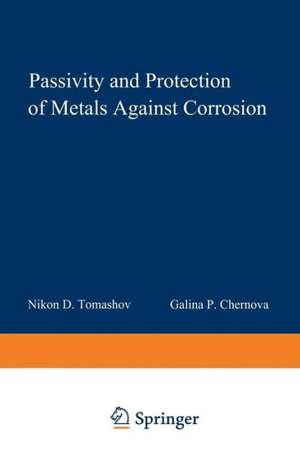Passivity and Protection of Metals Against Corrosion
Autor N. D. Tomashoven Limba Engleză Paperback – 8 mar 2012
Preț: 383.50 lei
Nou
Puncte Express: 575
Preț estimativ în valută:
73.38€ • 79.96$ • 61.84£
73.38€ • 79.96$ • 61.84£
Carte tipărită la comandă
Livrare economică 23 aprilie-07 mai
Preluare comenzi: 021 569.72.76
Specificații
ISBN-13: 9781468417302
ISBN-10: 1468417304
Pagini: 228
Ilustrații: XVI, 208 p.
Dimensiuni: 152 x 229 x 12 mm
Greutate: 0.31 kg
Ediția:Softcover reprint of the original 1st ed. 1967
Editura: Springer Us
Colecția Springer
Locul publicării:New York, NY, United States
ISBN-10: 1468417304
Pagini: 228
Ilustrații: XVI, 208 p.
Dimensiuni: 152 x 229 x 12 mm
Greutate: 0.31 kg
Ediția:Softcover reprint of the original 1st ed. 1967
Editura: Springer Us
Colecția Springer
Locul publicării:New York, NY, United States
Public țintă
ResearchCuprins
A Note on Soviet Alloy Designations.- I The Phenomenon of Passivity in Metals.- Definition of Passivity.- Mechanism and Theory of Passivity.- Electrochemical Methods for Investigating Passivity.- Anodic Potentiostatic Charge Curves.- Anodic Galvanostatic Charge Curves.- Cathodic Reduction Curves.- Study of Potential Drop Curves.- Measurement of the Double-Layer Capacity.- Study of the Kinetics of Electrode Processes Under the Action of Alternating Currents.- Investigation of the Nature and Structure of Passive Films..- Optical Method.- Electron Diffraction.- Microchemical Method for Determining Film Composition.- Kinetics of the Anodic Processes.- Anodic Processes on a Passive Electrode.- Method of Plotting Potentiostatic Curves.- II Passive Systems.- Active State.- Passive-Active State.- Spontaneously Stable Passive State.- Pitting Formation.- The Transpassive State and Secondary Passivity.- Construction of Corrosion Rate-Potential Curves.- III Basic Principles for Increasing the Corrosion Resistance of Alloys by Increasing Their Passivity.- Inhibiting the Anodic Process.- Reduction of Corrosion in Passive Systems by Increasing the Effectiveness of the Cathodic Process.- IV Anodic Protection.- Anodic Protection of Stainless Steels.- Anodic Protection of Carbon Steels.- Anodic Protection of Titanium.- Practical Application of Anodic Protection.- Prospects for the Development of Anodic Protection.- V Passivation of Metals by Contact with Cathodes.- Use of Cathodic Protectors.- Cathodic Coatings.- of Cations of Electropositive Metals into the Corrosive Medium.- VI Passivation of Metals by the Introduction of Oxidizers into the Corrosion Medium.- Mechanism of the Protective Effect of Oxidizing Inhibitors.- Nature of the Oxidizing Inhibitor.- Effect of the Metal and Aggressiveness of the Medium.- References.

